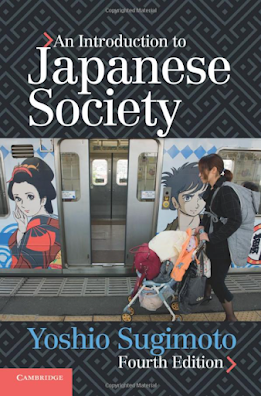You Might Want to Read: An Introduction to Japanese Society by Yoshio Sugimoto
This is the second in a series of blog posts that I'm doing where I review books that are specifically about Japan and Japanese culture that I think fans of anime might enjoy reading. The first book I reviewed was Pure Invention by Matt Alt. Pure Invention takes a look at Japan through the lens of its exports. Japanese exports are how most people reading this post are likely to have interacted with Japan. Those products were made in historical and cultural contexts that Matt Alt was able to examine only briefly, given the scope of the book. But what if a reader wanted to learn more about Japanese people and Japanese society? Especially Japanese people who aren't closely connected to the dominant Tokyo culture.
Who is Yoshio Sugimoto and What Is An Introduction to Japanese Society
An Introduction to Japanese Society is a fairly self explanatory title. It is an academic, annotated, and meticulously cited introduction to various facets of Japanese society. Sugimoto is particularly interested in challenging the idea that Japan is a monoculture. Sugimoto presents a heterogenous Japan that struggles with many of the same problems caused by social division that other countries face. Far from fitting neatly into one mold, the people of Sugimoto's Japan are a cosmopolitan mix of race, class, gender, sexual orientation, geographical location, political status, and even caste.
Sugimoto makes an interesting case that an affluent dominant culture in Tokyo monopolizes access to both government and media, and that the Japan that is presented to the world is far from the complete picture. Every chapter sent me down a different research rabbit hole. There are many terms I had never heard before reading this book, for example: burakumin and zainichi. It is a book that will leave most readers with many more questions than answers. For my readers, the most interesting question may be whether or not the worldwide "Cool Japan" phenomenon is as beneficial to Japan as it may seem at first glance.
Strengths and Weaknesses
This is a book that is literally taught in universities. The information is solid, well researched, well cited, and thorough. Sugimoto's multicultural model of Japan is very interesting and is more in line with my understanding of humanity than Japan being an extremely rare example of a country with near absolute uniformity; however, in the pursuit of developing the multicultural model, I have seen criticisms that some of the differences Sugimoto mentions are overemphasized. For example, Sugimoto argues that regional dialects and accents are almost like separate languages for those who must learn to use the dominant Tokyo accent to move forward socially/professionally. I don't know enough about the language to really say if that's the case. This sounds more like linguistic code-switching to me, but this is another area for study, I suppose.
Probably the biggest weakness of the book is its academic sterility. It's not that the book is inaccessible to a lay-person. All inside-baseball sociological terms and principles are explained, as are many of the Japanese words used. It's just dry. It can be repetitive, even within the same chapter. My interest outweighed my boredom, but I won't pretend that parts of it weren't a slog.
There's one more complaint I have, and that is the Sociologist's propensity to divide things along two axes. For example, Rich vs Poor and Educated vs Uneducated. Dividing these groups along 2 axes would produce 4 categories: Rich Educated, Rich Uneducated, Poor Educated, Poor Uneducated. I don't find this sort of thing very productive. In a book that is all about deconstructing broad generalizations, pausing to make some slightly less broad generalizations and then discussing each category in detail (often retreading the same territory already discussed) is a waste of time.
Should you read this?
This is a book for those who are somewhat serious about their Japan Studies. It is an introductory text. It is perfectly understandable to the average reader, but it is boring. I think that most people born outside of Japan will find at least a few new and interesting topics to study, but if you are a person who struggles to sit down and read dry text for long periods of time then this book may not be worth the cost. The cost by the way, is upwards of $35 new. I got a used copy for $5, but this is something that I find hard to recommend to general audiences.




Comments
Post a Comment